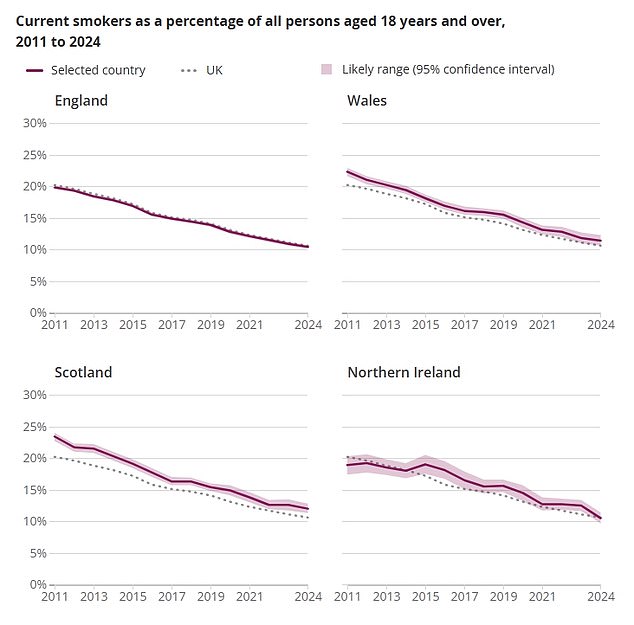For the first time in history, more adults in the UK are choosing vapes over traditional cigarettes.
New data from the Office for National Statistics (ONS) shows that 5.4 million adults now regularly use e-cigarettes, slightly outnumbering the 4.9 million who still smoke.
This shift marks a historic milestone in Britain’s long-running battle against tobacco.
Smoking Rates Continue to Plunge
The decline in cigarette smoking has been dramatic over the past few decades.
Just 9.1 per cent of adults smoked in 2024 — a far cry from nearly half of all adults in the 1970s.
ONS analysts have even created an interactive map allowing people to see exactly how many smokers live in their area, highlighting the scale of the cultural shift.
David Mais from the ONS explained, “Our 2024 data show that, for the first time, the number of e-cigarette users has overtaken the number of smokers.
About 10 per cent of adults said they use vapes compared with 9.1 per cent who smoke cigarettes.
This follows the long-term trend of falling smoking rates over the past decade.”
Young Adults and Women Drive the Vaping Trend
E-cigarette use remains particularly high among young adults aged 16 to 24, with 13 per cent reporting regular or occasional use.
This is despite strict laws banning the sale of vapes to under-18s, enforced with fines and legal action by Trading Standards.
Campaigners have raised concerns over the marketing tactics used by vape manufacturers, accusing them of targeting teens with brightly coloured packaging and flavours such as bubblegum and cotton candy.
Women are emerging as a key driver of the trend, with vaping rates rising almost a fifth in a year.
In 2024, around one in ten women reported using e-cigarettes daily or occasionally, up from 8.5 per cent in 2023.
Meanwhile, rates among men dipped slightly from 11 per cent to 10.1 per cent over the same period.
E-Cigarettes as a “Healthier Alternative”
Many users have been drawn to vaping because it offers a nicotine hit without the tar or carbon emissions produced by traditional cigarettes.
E-cigarettes work by heating a liquid that usually contains nicotine, propylene glycol, glycerine, and flavourings to create a vapour, allowing users to inhale without burning tobacco.
ONS data also revealed that around 2.7 per cent of people who have never smoked now use e-cigarettes either daily or occasionally, showing that vaping is attracting some new users rather than just helping smokers switch.
Smoking Decline Linked to Policy and Public Health Measures
Experts say Britain’s long-running anti-smoking campaigns have played a major role in driving cigarette use down.
Measures include plain packaging for cigarettes, graphic health warnings, and bans on smoking in restaurants, pubs, and nightclubs.
The trend is clear: smoking is on the decline. From around 45 per cent of adults smoking in the 1970s, the rate fell to 20 per cent in 2011, 14 per cent in 2020, and just 9.1 per cent in 2024.
England has set an ambitious goal to become completely smoke-free by 2030, with further measures under discussion, such as banning smoking on pavements outside pubs and restaurants.
Share on Facebook «||» Share on Twitter «||» Share on Reddit «||» Share on LinkedIn
